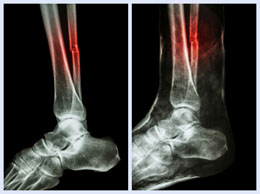There are a few very important things to be known about a fracture of the fibula, in order to get appropriate treatment. This Buzzle article will explain the details that relate to the symptoms, treatment options, and recovery period for this condition.

Injury to a bone causing a break or crack is known as a fracture. The lower leg is made up of two bones, the tibia and fibula, which run parallel to each other. Of the two bones, the tibia is the one prone to breakage, since it is the weight bearing bone. However, a fractured fibula is often associated with a fracture of the tibia, since the force that causes a crack in the tibia is transferred to the fibula as well. Open bone fractures are those that cause a break in the skin, and since, the skin covering the anterior portion of the tibia is relatively thin, fractures of the lower leg are often open, or are fractures where the hematoma is exposed, making the bone prone to contamination. Fibula fractures alone are rare, and generally do not cause long-term complications, although in certain cases, where the fracture is segmented, it may cause nerve damage.
Symptoms
A fractured fibula unaccompanied by a tibial fracture is likely to heal faster. The typical symptom of a fracture is pain accompanied by localized swelling at the site. The pain is likely to be severe, especially when walking or when pressure is put on the leg. In the case of a closed fracture (where the skin does not break), there may be discoloration surrounding the site. Any movement can cause a great deal of pain. There may be visible deformity, if the fracture is severe enough to cause the bones in the leg to separate.
Treatment
The treatment of any fracture will vary depending on the type of fracture. If it is only the fibula that is fractured, and not the tibia, home treatment and care may be sufficient for the healing to progress. Initial treatment will involve elevation of the leg accompanied by ice applied to the site, to reduce inflammation and swelling. Rest and regular cold pack therapy are likely to be the immediate course of treatment to relieve pain.
If the fracture is an open one, intravenous antibiotics may be prescribed, to reduce the risk of an infection. If the fracture is closed, but the bones close enough to each other as revealed through an X-ray of the affected limb, an orthopedic practitioner may bring the fragments as close a possible, and then fit a plaster or cast over the affected bone, to immobilize the limb, which, over time, will rejoin and heal. If the fracture has resulted in the bone splintering or breaking into fragments that are displaced, a doctor may recommend surgery to re align displayed bone fragments. In some cases, this may involve the use of rods that are inserted into the leg, a plate and screw, or a frame that is fitted around the bone, to hold it in place. Generally, splinters or fragments are caused when there is a heavy blow causing extensive trauma, such as in the case of a gunshot wound.
Recovery
Typically, the recovery time for a fractured fibula will range from anything between 12 to 16 weeks, depending on the severity of the fracture, and the method of treatment to be administered is immobilization through a cast. Following this, the affected person may be advised a course of physiotherapy, focusing on a range of motion exercises, and on building muscle strength that may have been compromised during the weeks of extended rest.
If uncomplicated, the chances of complete recovery are good, even more so, if it is the fibula that is fractured in isolation, and the tibia is intact. Certain people constitute high-risk groups, such as those involved in high-risk contact sports, those who participate in repetitive impact exercises, such as jogging or running, and those who suffer from bone strength depleting conditions like osteoporosis or osteoarthritis. However with proper care, a full recovery is possible.


 Injury to a bone causing a break or crack is known as a fracture. The lower leg is made up of two bones, the tibia and fibula, which run parallel to each other. Of the two bones, the tibia is the one prone to breakage, since it is the weight bearing bone. However, a fractured fibula is often associated with a fracture of the tibia, since the force that causes a crack in the tibia is transferred to the fibula as well. Open bone fractures are those that cause a break in the skin, and since, the skin covering the anterior portion of the tibia is relatively thin, fractures of the lower leg are often open, or are fractures where the hematoma is exposed, making the bone prone to contamination. Fibula fractures alone are rare, and generally do not cause long-term complications, although in certain cases, where the fracture is segmented, it may cause nerve damage.
Injury to a bone causing a break or crack is known as a fracture. The lower leg is made up of two bones, the tibia and fibula, which run parallel to each other. Of the two bones, the tibia is the one prone to breakage, since it is the weight bearing bone. However, a fractured fibula is often associated with a fracture of the tibia, since the force that causes a crack in the tibia is transferred to the fibula as well. Open bone fractures are those that cause a break in the skin, and since, the skin covering the anterior portion of the tibia is relatively thin, fractures of the lower leg are often open, or are fractures where the hematoma is exposed, making the bone prone to contamination. Fibula fractures alone are rare, and generally do not cause long-term complications, although in certain cases, where the fracture is segmented, it may cause nerve damage.